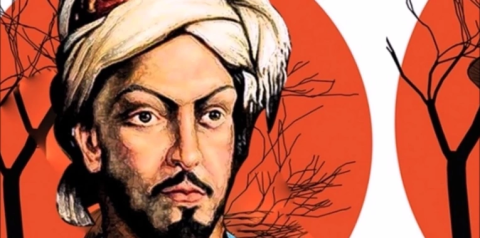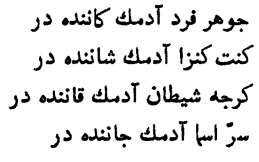Imadeddin Nasimi: Man as an Inscription
Primary tabs

Translator: Emil Rahimov
From Alexander Dugin, Noomakhia: The Horizons and Civilizations of Eurasia – The Indo-European Legacy and the Traces of the Great Mother (Moscow: Academic Project, 2017)
We encounter a very similar model of radical Sufism in the writings of the Azerbaijani poet, Imadeddin Nasimi (c. 1369-1417), who also wrote in Turkic (as well as in Farsi and Arabic). Nasimi was a follower and student of Fazlullah Naimi (1339-1401), the founder of a particular trend in Sufism — Hurufism. Hurufism was a current within Sufism, analogous to the Jewish Kabbalah. Fazlullah Naimi was an Iranian poet and Sufi philosopher. He developed the doctrine that the world is made of letters (of the Arabic and Persian alphabets), and that the shape of letters and their combinations are a set of all possible combinations of the Universe. Operations with letters can influence events and serve as a path to spiritual elevation. Fazlullah Naimi considered himself a messenger of God who revealed the truth to the world. First, he decided to spread his teaching and the revelation of his mission among the people of Tabriz in Azerbaijan, which became known among his followers as the “Land of Resurrection” (Sarzamin-i Rastakhiz).
For his views, Naimi was subjected to persecutions and ultimately executed at the hands of the Timurids, who ruled Iran at that time. While in prison, he wrote his main work (Javidan-nama, literally The Book of Eternity), where he expounded the doctrine of sacred letters in its final form. Besides this, he compiled the Book of Dreams (Navm-nama) and other important works in the spirit of extreme Sufism, while also bearing numerous parallels to Ismailism. In the description of one of his dreams in which he met Muhammad, he talks about the practice of observing the seven stars from a certain angle. During this experience, the brightest star penetrates his eye, after which he gains the ability to comprehend the essence of things — the rays of the Logos scattered within them. Naimi considered himself to be an incarnation of Divinity. He interpreted dreams, predicted the future, and claimed to understand the language of birds. But his main mission was to discover the Logos in the world’s every structure — in the universe, man, history, and religion. This is what he called “Resurrection” (Rastakhiz). Again, here we havea direct parallel with the Ismaili concept of “Resurrector” (al-Qa’im) and “Resurrection” (al-Qiyamah).
Imadeddin Nasimi was a follower of Naimi and preached his teachings. At the same time, strictly continuing the line of Persian-Turkic Sufism, he was an ardent adherent of al-Hallaj, considering him to be the bearer of the highest truth of the Sufi doctrine. The doctrine of the identity between man’s inner, “perfect nature” and the Divinity itself is expounded with the utmost transparency by Nasimi. Like Yunus Emre, Nasimi writes some poems from the perspective of this “supreme identity”, the divine I.
Both worlds can fit within me, but into this world I cannot fit
I amessence, I have no place, into being I cannot fit.
Everything that was, is and will be, everything is embodied in me,
Don’t ask! Follow me. Into explanations I cannot fit.
The universe is my harbinger, my beginning is your life,
Recognize me by these signs, but into these signs I cannot fit.
By assumption and doubt, no one has reached the truth,
He who has learned the truth knows, into assumptions I cannot fit.
Take a deeper look into my image and strive to see the meaning,
I am of body and soul, into a soul with body I cannot fit.
I am a pearl, hidden in a shell. I am a bridge leading to hell and heaven,
Know that with such wealth, into the stalls of the world I cannot fit.
I am the most secret of all treasures, I am the manifestness of all worlds,
I am the source of jewels, into the seas and depths I cannot fit.
Although I am great and boundless, but I am Adam, I am a man,
I am the creation of the universe, but into creation I cannot fit.
I am all times and all ages. The soul and the world are all me!
But does no one find it strange that in these, too, I cannot fit.
I am the horizon, I am all the planets, and I am the Angel of Revelation,
Hold your tongue behind your teeth, into your tongue I cannot fit.
I am the atom of all things, I am the sun, I am the six sides of your earth.
Now look at my clear face, into this clarity I cannot fit.
I am at once essence and character, I am sugar and rose in half,
I am myself the decision and the justification, into a silent mouth I cannot fit.
I am a wood in fire, I am a stone that has ascended to heaven,
Admire my flame, into this flame I cannot fit.
I am a sweet dream, the moon and the sun. The breath, the soul, I give.
But even in the soul and breath, all at once I cannot fit.
Although today I am Nasimi, I am Hashimite and Quraysh,
I am less than my own glory, but into glory I cannot fit.
In another poem, Nasimi directly (like Rumi and Emra) quotes al-Hallaj:

I have found the truth! I am the Truth! I proclaim.
I am the Truth. The truth is in me, I proclaim the truth.
See how mystically I proclaim these secrets.
I am truthful in my utterances. “Bow down before my truthfulness! ” I proclaim.
In some of his quatrains, Nasimi goes even further:

I am absolute being, my affirmations are absolute.
The truth is the witness. The truth knows that I affirm the truth.
The mystery of “I was a hidden treasure” I affirm in a mystical way.
I extended my finger. The moon has been split, I affirm.
This is the apotheosis of metaphysical power and an achievement of the highest level of the Sufi path — a penetration into the worlds of haqiqat. The formula from the hadiths —”I was a hidden treasure, but I wanted to be known and created a creation”— is the basis of Sufi metaphysics. In Arabic, it sounds like this:

The beginning of the formula is also reproduced in Nasimi’s quatrain. It is important to note here that God expresses the will to be known (‘arif), which refers to the third level of Sufism — ma’rifah. God is the Truth. But this truth is deliberately apophatic (the neo-Platonic, super-existential, and unknowable Hen [ἓν]). In order to be known, Truth makes creation. But the act of knowing is the Logos, which means that the universe is the unfolded Logos. On this basis, the Hurufites identify the world with the sacred text. However, the world itself concentrates its Logos-essence into one pole — man. He is, in the end, the instance in which He who wants to be known is known. The Knower of that which is Unknowable but strives to be known, is extremely close to the object of knowledge. So, man himself becomes the Logos of the universe, penetrates into the essence of things and attains absolute power (the split moon). At the same time, the Logos is conceived by the Hurufite Nasimi as an ordered system of signs, that is, as a script, as scripture. The nature of man (Adam) encompasses everything precisely because man is nothing other than the Logos. Adam is a divine inscription that can read itself, and through this (i.e., everything else), can read the world. This reading of the world constitutes a knowledge of God attained through the “marifat“, that is, His cataphatic unfolding.
Nasimi writes:

The Priceless diamond in Adam’s vein
“I was a hidden treasure” in Adam’s nature
Although the devil too is in Adam’s blood
The secret of names is in Adam’s soul
Adam-Logos contains all opposites. He is not only good and light, he embraces all versions of manifestation, including its dark sides, integrating them into himself. Hence the Dionysian character of the Sufi Logos of Nasimi.
The Hurufites’ interpretation of the Logos as an inscription is not typical of the Turks or the nomadic peoples of Turan in general, since their main emphasis was on oral tradition. However, Hurufism probably restored the tradition of sacred signs, known to the most ancient peoples of Turan. The Turkic tamga and Eurasian runes could be prototypes of such generalizing symbolic systems.
In general, Nasimi’s poetic metaphysics represents a complete and coherent Platonism. But we find such Platonism already in Yassavi, and then in the entire tradition of Turkish Sufism. In its structure, it hardly differs from the classical Iranian metaphysics of the Islamic period, where the ancient Indo-European heritage (the Logos of Apollo), Mazdean dualism (the war of light and eschatology), and Hellenic Neoplatonism converge. This is a vivid manifestation of the Iranian Logos. In this case, it is strictly the language that is Turkic. However, it should be noted that the Turkic peoples of Turan had ancient precedents for such a deep perception of the Iranian tradition, since the Logos of Turan itself is, in turn, Indo-European in its origins and roots, and therefore the Turkic Dasein was originally structured along the semantic axis of the Logos of Apollo.
It is significant that the Turk Nasimi died a martyr’s death in Aleppo — the Zahirite mullahs skinned him alive. Sufi legends claim that the executed poet then got up, wrapped himself in his skin like a Sufi cloak (khirka) and calmly left. No one ever saw him again. Thus, Nasimi repeated the martyrdom of Mansur al-Hallaj, Suhrawardi, and his teacher Fazlullah Naimi, the faith in whom Nasimi carried through his life and embodied in the grand monument of his creations.
Source: Eurasianist Internet Archive
